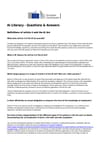📘 What’s Covered
This resource provides concrete answers to 40+ frequently asked questions about how to implement AI literacy measures under the EU AI Act. It’s structured around key themes:
1. Definition and Scope
The Q&A starts by clarifying what AI literacy means under Article 3(56) of the Act: the skills, knowledge, and understanding necessary to responsibly deploy, use, or be affected by AI systems. It explains how Article 4 requires both providers and deployers to ensure a “sufficient level” of AI literacy—covering not just employees, but also contractors and partners acting on their behalf.
2. Who Needs Training and When
It confirms that no specific certificate or training format is mandated, but emphasizes that relying solely on instruction manuals is not enough—particularly for high-risk systems. The guidance encourages tailored programs, reflecting differences in technical expertise, job roles, and sector context.
3. Implementation and Risk Differentiation
The Q&A outlines a risk-based approach, noting that high-risk systems (as defined in Annex III of the AI Act) may require deeper, more targeted training. It also recognizes the importance of documenting internal training actions and provides examples of questions companies should ask themselves when designing AI literacy initiatives.
4. Enforcement and Timelines
The document confirms that Article 4 entered into force on 2 February 2025, while enforcement begins 2 August 2026. National market surveillance authorities—not the AI Office—will be responsible for supervision and penalties.
5. Resources and Guidance
Links to several useful tools are included:
- AI Pact webinars and recordings
- The “Living Repository” of AI literacy practices
- Links to EDIHs, DigComp 2.2, and UNESCO AI competency frameworks for teachers and students
It also highlights how the Commission is supporting AI literacy internally with training portals, tools guidance, and tailored learning paths for different staff roles.
💡 Why it matters?
AI literacy is no longer a buzzword—it’s a legal compliance issue. This Q&A makes it easier for organizations to understand what the EU expects, even in a fast-changing environment. It ties AI ethics, transparency, and human oversight together with practical compliance and workforce training.
For companies navigating the AI Act, this is a reminder that regulatory readiness starts with people. Staff need to understand not just how AI works, but also where it can go wrong. That’s particularly crucial for high-risk AI systems, where poor literacy could translate directly into enforcement action or legal liability.
🧩 What’s Missing
- Templates or checklists: The document offers conceptual guidance, but lacks downloadable formats or compliance rubrics that legal or HR teams could implement directly.
- Sector-specific guidance: While the Q&A says context matters, it doesn’t provide examples tailored to healthcare, finance, or education.
- Cross-references with GDPR or whistleblower frameworks: These could further anchor Article 4 in organizations’ broader governance structures.
🎯 Best For
- Compliance teams and legal counsels working on EU AI Act implementation
- AI product leads and HR directors looking to roll out literacy training
- Public sector agencies and SMEs preparing for audits or exploring available EU support tools
📝 Source Details
- Title: AI Literacy – Questions & Answers
- Published by: European Commission
- Date: May 2025 (Q&A format)
- URL: Link
- License: Creative Commons Attribution 4.0


